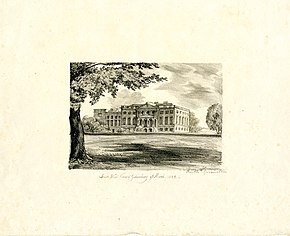


Old Gorhambury House located near St Albans, Hertfordshire, England, is a ruined Elizabethan mansion, a leading and early example of the Elizabethan prodigy house.
History
The old house
It was built in 1563–68 by Sir Nicholas Bacon, Lord Keeper, and was visited a number of times by Queen Elizabeth I. It is a Grade I listed building.
The house was built partly from bricks taken from the old Abbey buildings at St Albans, then in process of demolition following the Benedictine priory's dissolution some 25 years earlier. It was used as a residence by his youngest son, the polymath (scientist, philosopher, statesman and essayist) Sir Francis Bacon, before being bequeathed by him to his former secretary, Sir Thomas Meautys, who married Anne Bacon, the great-granddaughter of Sir Nicholas.
The estate passed in 1652 to Anne's second husband Sir Harbottle Grimston, Master of the Rolls and Speaker in the Convention Parliament of 1660. The estate is owned by the Grimston family to the present day, having been passed via Harbottle Grimston's son Samuel, who died childless in 1700, to his great-nephew William Luckyn, who in turn became the first Viscount Grimston in 1719.
The house fell into ruin after the construction of New Gorhambury House in the 18th century, but was retained as a feature within landscaped parkland. The surviving remains include a two-storey porch, chapel and clock tower.
The new house
Main article: Gorhambury HouseIn the years 1777–84, the current Palladian-style Gorhambury House was built nearby. Designed by Sir Robert Taylor and commissioned by James Bucknall Grimston, 3rd Viscount Grimston, it replaced Old Gorhambury House. It remains the home of the Earl of Verulam.
The current house is a member of Historic Houses and is open for tours at certain times.
Garden
The mason and sculptor William Cure I, father of Cornelius Cure, made and installed a fountain at Gorhambury in September 1568. At this time, Bacon was making improvements at Redgrave Hall, where the masons who made the steps for the Gorhambury fountain were also employed.
The "pondyards", the remains of water garden near the River Ver, were scheduled in 2020 under the Ancient Monuments and Archaeological Areas Act 1979. The feature was laid out in the 17th century for Sir Francis Bacon, possibly adapting preexisting ponds.
Access
The site is maintained by English Heritage and is free to visit.
References
- ^ "Old Gorhambury House". English Heritage.
- Historic England. "Remains of Old Gorhambury House (1175197)". National Heritage List for England. Retrieved 23 October 2013.
- "Hertfordshire Genealogy webpage".
- "Parishes: St Michael's | British History Online". www.british-history.ac.uk.
- "Traffic-chaos wedding was that of Earl of Verulam's daughter". Herts Advertiser.
- Gorhambury House : Historic Houses Association
- Diarmaid MacCulloch, Letters from Redgrave Hall (Suffolk Record Society, Boydell, 2007), p. 30 no. 38.
- "Gorhambury Pondyards (Historic England: Shipwreck and Selfridges on 2020 protected list)". BBC. Retrieved 22 December 2020.
External links
- Old Gorhambury - Official Webpage
- Old Gorhambury House - English Heritage webpage
- Photographs of Old Gorhambury House
- A Guide to Old Hertfordshire webpage on Gorhambury
- Webpage regarding Old Gorhambury House on Sir Francis Bacon's New Advancement of Learning website, including anecdotes about the young Francis Bacon's conversations with Queen Elizabeth
- The Gorhambury Estate & Leverstock Green
- Gorhambury House - Historic Houses Association, information on visits
- Tour UK webpage for the current Gorhambury House
51°45′25″N 0°23′36″W / 51.75694°N 0.39333°W / 51.75694; -0.39333
Categories: